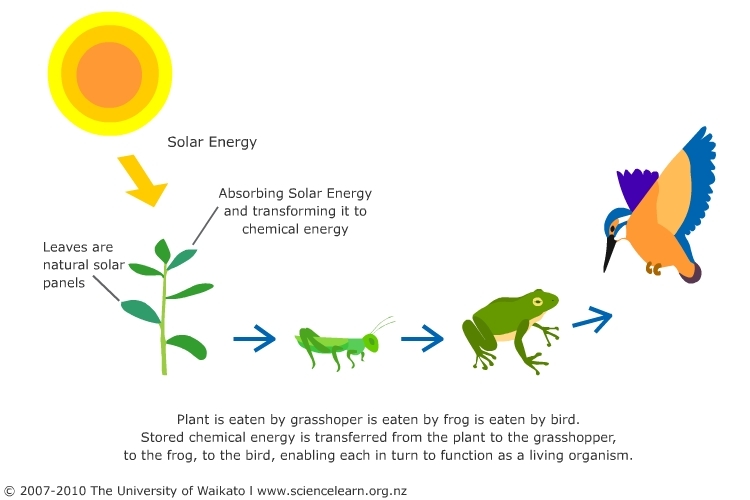Sunlight is converted to chemical energy during the process of photosynthesis in autotrophic organisms. Carbohydrate molecules store this energy.
Photosynthesis is the mechanism by which organisms with chlorophyll pigment convert light energy into chemical energy. Sunlight, being a form of radiant energy, is transformed into chemical energy and stored in glucose molecules. This stored energy is used by the cells for various metabolic reactions and is essential for the functioning and growth of the organisms.

Radiant Energy To Chemical Energy
The sunlight falling on the Earth’s surface is converted into different forms of energy, with one of the primary conversions being from radiant energy to chemical energy via the process of photosynthesis.
Conversion In Photosynthesis
Photosynthesis is a vital biochemical process wherein radiant energy from the sun is transformed into chemical energy. It takes place in the chloroplasts of plant cells, involving the conversion of carbon dioxide and water into glucose and oxygen, using light energy via the assistance of chlorophyll.
Storage Of Chemical Energy
The chemical energy derived from sunlight during photosynthesis is stored in the form of glucose, a simple sugar. Additionally, this energy is further utilized to synthesize adenosine triphosphate (ATP), the energy currency of the cell. The stored energy in glucose serves as a foundational energy source for all living organisms, supporting their various metabolic reactions.
Process Of Photosynthesis
Photosynthesis is a crucial process that occurs in autotrophic organisms, typically plants, where sunlight is converted into chemical energy. This process plays a vital role in the production of oxygen and the formation of glucose, which serves as a storage molecule for energy within plants. Let’s dive deeper into the various stages of photosynthesis to understand how sunlight is captured and converted.
Capture Of Sunlight
Sunlight is taken in as the first step in photosynthesis. Plants have specialized structures called chloroplasts that contain a pigment called chlorophyll. This pigment absorbs sunlight, particularly in the red and blue wavelengths, while reflecting the green light. The captured sunlight is then used as an energy source for the subsequent reactions in the photosynthetic process.
Light-dependent Reactions
Once the sunlight is captured, the light-dependent reactions take place within the chloroplasts. These reactions occur in the thylakoid membrane, where specialized proteins and pigments work together to convert light energy into chemical energy. During this phase, molecules of adenosine triphosphate (ATP) and nicotinamide adenine dinucleotide phosphate (NADPH) are produced. Both ATP and NADPH serve as carriers of energy, which will be utilized in the next stage of photosynthesis.
Formation Of Sugar
The next stage is the formation of sugar. The light-dependent reactions provide the necessary energy in the form of ATP and NADPH to power the Calvin cycle, also known as the light-independent reactions. In this cycle, carbon dioxide from the atmosphere is combined with the ATP and NADPH to produce glucose (C6H12O6). Glucose is a vital carbohydrate that can be stored and transported within the plant for later use as an energy source.
Storage Of Carbohydrates
Finally, the glucose molecules formed during photosynthesis are stored as carbohydrates within the plant. This stored energy can be utilized for various metabolic processes, growth, or reproduction as needed by the plant. Additionally, excess glucose can be converted into starch or other complex carbohydrates for long-term storage.
Forms Of Energy Involved
Sunlight serves as a vital source of energy for various biological and geological processes on Earth. Through a process called photosynthesis, sunlight is converted into different forms of energy that play essential roles in sustaining life. Let’s explore two main forms of energy involved in this remarkable process: kinetic energy and potential energy.
Kinetic Energy
Kinetic energy is the kind of energy that moves things. During photosynthesis, sunlight provides the initial energy needed to initiate the process. Chlorophyll, the pigment responsible for capturing sunlight in plants, absorbs photons from sunlight. As a result, the absorbed energy facilitates the movement of electrons within the chlorophyll molecules, creating an electron flow.
This movement of electrons represents kinetic energy in action. It drives the chemical reactions involved in photosynthesis, including the synthesis of adenosine triphosphate (ATP) and the production of the energy-rich compound NADPH. ATP and NADPH act as carriers of energy throughout the plant cells, powering various metabolic activities essential for growth and development.
Potential Energy
Potential energy refers to stored energy that can be released and utilized when needed. In photosynthesis, this form of energy manifests in the chemical bonds of glucose molecules and other carbohydrates produced during the process. Glucose serves as the primary energy storage molecule in most plants and other organisms that undergo photosynthesis.
Once glucose is synthesized, it can be stored in various ways within the plant. Some glucose molecules may be converted into starch, a polysaccharide that acts as a long-term energy reservoir. Starch can be stored in specialized structures like roots, tubers, and seeds, providing a readily available energy source for future use.
Other glucose molecules may be immediately utilized in cellular respiration to generate ATP, the energy currency of the cell. Through cellular respiration, the potential energy stored in glucose is converted back into kinetic energy, fueling the vital processes in the plant cells.
During photosynthesis, sunlight is converted into kinetic energy and potential energy. The captured energy drives essential metabolic reactions and is stored in the form of ATP and glucose, respectively. This energy conversion and storage mechanism enables plants to harness sunlight, sustain their growth, and supply energy to the ecosystem.

Credit: www.sciencelearn.org.nz
Role Of Atp And Nadph
ATP (Adenosine Triphosphate) and NADPH (Nicotinamide Adenine Dinucleotide Phosphate) play a vital role in the conversion of sunlight into chemical energy during photosynthesis. They serve as energy carriers and are essential for the production of carbohydrates.
Energy Carriers
ATP and NADPH act as energy carriers in the photosynthetic process. ATP is a high-energy molecule that provides energy for various cellular activities. Meanwhile, NADPH carries high-energy electrons and hydrogen, which are necessary for the synthesis of organic molecules.
Production Of Carbohydrates
ATP and NADPH, generated through the light-dependent reactions of photosynthesis, are utilized during the production of carbohydrates. These molecules provide the necessary energy and reducing power for the conversion of carbon dioxide and water into glucose, a fundamental source of energy for plants and other organisms.
Overall Energy Conversion
During photosynthesis, sunlight is converted into chemical energy. This energy is then stored in the form of glucose molecules, which serve as fuel for various metabolic reactions in living organisms.
From Radiant Energy To Potential Energy In Carbohydrates
In photosynthesis, sunlight is converted into chemical energy through a series of intricate processes. This conversion allows autotrophic organisms, predominantly plants, to store the energy they need to fuel their metabolic reactions.
During photosynthesis, plants capture radiant energy from the sun using pigments such as chlorophyll. This radiant energy is then transformed into chemical energy in the form of ATP, adenosine triphosphate, which serves as the primary energy-storing molecule in living organisms.
The conversion of sunlight into chemical energy occurs within the chloroplasts of plant cells. Within these specialized organelles, sunlight is absorbed by chlorophyll and other pigments, initiating a cascade of biochemical reactions.
Through a complex process known as the light-dependent reactions, the radiant energy of sunlight is used to power electron transport chains. These chains generate ATP and reduce molecules such as NADP+ to NADPH, providing the necessary energy carriers for the subsequent steps of photosynthesis.
Once the radiant energy is harnessed and converted into ATP and NADPH, it is then utilized during the light-independent reactions, also known as the Calvin cycle. In this cycle, carbon dioxide is converted into carbohydrates such as glucose.
The chemical energy stored in glucose is a result of the capture and conversion of sunlight. Glucose molecules serve as long-term energy storage units for plants. They can be broken down as needed to provide the energy necessary for growth, development, and other essential cellular processes.
Overall, the conversion of radiant energy from sunlight to potential energy in carbohydrates is a fundamental process that enables plants to sustain life and support ecosystems. Through photosynthesis, plants not only capture and utilize sunlight but also play a crucial role in the global cycling of carbon and the production of oxygen.

Credit: slideplayer.com

Credit: phys.org
FAQs On What Form Of Energy Is Sunlight Converted To
What Is The Energy From The Sun Will Be Converted To?
The energy from the sun is converted to chemical energy, mainly in the form of glucose molecules, during the process of photosynthesis. This chemical energy is stored and utilized by living organisms.
What Is The Process Of Photosynthesis Sunlight Converted To?
During photosynthesis, sunlight is converted into chemical energy. Carbohydrate molecules store this energy.
What Is The Energy Of The Sun Changed To?
The energy of the sun is converted into chemical energy through the process of photosynthesis. The molecules of glucose are responsible for storing this energy.
What Convert Light Energy From The Sun Into?
During photosynthesis, sunlight is converted to chemical energy, mainly stored in glucose molecules.
Conclusion
Sunlight is converted into chemical energy through the process of photosynthesis, where the energy is stored in the form of glucose molecules. This stored energy is vital for sustaining life and powering various metabolic reactions within organisms. Understanding this energy conversion process is crucial for appreciating the significance of sunlight in sustaining life on Earth.
